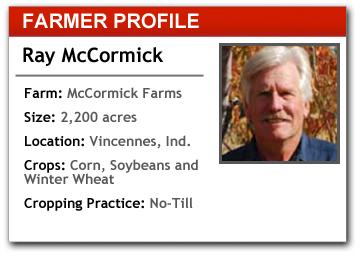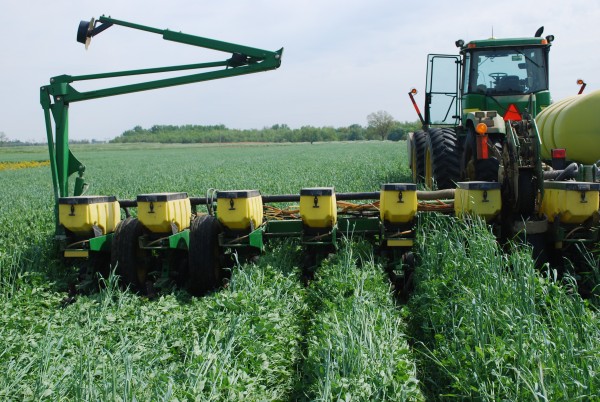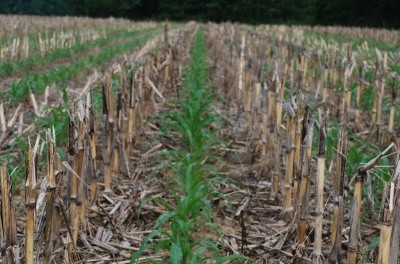 Ray McCormick’s goal is achieving healthy, functioning soils through never-till, cover crops, nutrient management and technology.
Ray McCormick’s goal is achieving healthy, functioning soils through never-till, cover crops, nutrient management and technology.
“My greatest investments in the last few years have all been technology driven,” he says.
He uses two John Deere Apex 2 RTK systems that are moved from one piece of equipment to the next to produce repeatability in field functions and essential data collection in planting, spraying, variable-rate sidedressing and harvest.
“Repeatability is a significant advantage in our operation where we’re trying to do everything precisely and get the most from our land resource,” McCormick says. “Land recently auctioned in our area for $12, 500 per acre, so if we want more yields we have to pay a lot closer attention to our management decisions. For one, we’re trying to harvest more nutrients from the air and soil through cover crops and variable-rate apply nutrients by soil type and zones of yield potential.”
Variable rate applications rely on years of quality data collection, which he gets from his RTK system. Yield monitoring is what started McCormick on his path to precision technology. He eventually used John Deere’s StareFire with FS1 signal before upgrading to the Apex 2 RTK system. It has been a huge advantage due to the tree-lined fields and bottoms that often caused McCormick to lose signal with the FS1.
“The RTK is always up and I can skip over a slough in my bottom fields and pick the line right back up on the other side,” he says. “I also can leave the field and come back in three hours or three days and go to the exact point where I stopped. The data is all there for me to see, too. I can go back to the same spot from several years ago and know exactly what has been grown, applied or done at that point.”
Points of Pain
There has been a technology learning curve for McCormick, and he often relies on his son, Nate, to help with purchasing and setup of the new equipment.
“It was a headache the first few years, stopped in the field punching at the screen frustrated and not being able to reach anyone on the phone,” he says. “Having my son around is a great help because he catches on fast and can tell me what I’m doing wrong in most cases.

Ray McCormick uses RTK technology to precisely manage his extremely valuable acres (land recently sold in his area for $12,500 an acre). He’s able to split rows exactly for perfect placement of the new crop in relation to the old in his no-till system as well as guide variable-rate sidedress applications. RTK guidance also allows him to plant straight, repeatable rows without the assistance of markers into the dense cover crops he grows to produce nitrogen.

McCormick has got things fairly well figured out now, and has seen some improvement in his current system that make life easier. An upgrade did away with the annoyance and time-stealing task of having to enter field and task information every time he switched fields for data collection.
“Now, I only have to put in that I’m spraying a burndown or sidedressing nitrogen once and it will retain that information until I tell it I’m doing something different. I only have to put in the field information when I switch fields,” he says.
Juggling data cards is a pain he’d like to do away with.
“Moving cards back and forth is no good,” he says. “We spend a lot of time loading data, downloading data, and then not having the right card when we get to the field.”
Wireless systems are tempting, but still too cost-prohibitive for McCormick. He does see the need with keeping up with the technology wave, however.
“If you don’t invest, you’ll be left behind. I compare it to buying your first computer. It was hard to say if it would make you money, but in the long run you’d be completely out of the loop if you hadn’t taken that first step,” he says.
He’s doing his best to keep up, but precision technology upgrades have proven to be a time- and money-consuming endeavor.
“When you switch from one technology to the next, you often have to buy an expensive receiver, screen, harness, etc., and it adds up to thousands of dollars,” he says. “And you don’t always foresee all the different ways it will cost you. I may have to make adaptations to equipment, update software or trade in receivers if I want to use it for swath control on the sprayer as well as for variable rate control on my sidedress equipment.”
Having all John Deere equipment helped, but changing technologies was still a project that took many trips to the dealership and extra costs to get it working on all the pieces of equipment he wanted.
One potential solution is having an on-farm consultation to assess current equipment and identify where all and in what ways the farmer would like to use the new technology. Then, the dealer could provide a strategy for implementing the change as well as a total estimated cost.
“My dealership has been good about giving advice on the smartest moves I can make to ease transitions and more cost-effectively adopt the new technology, but the process is still a headache,” he says.






